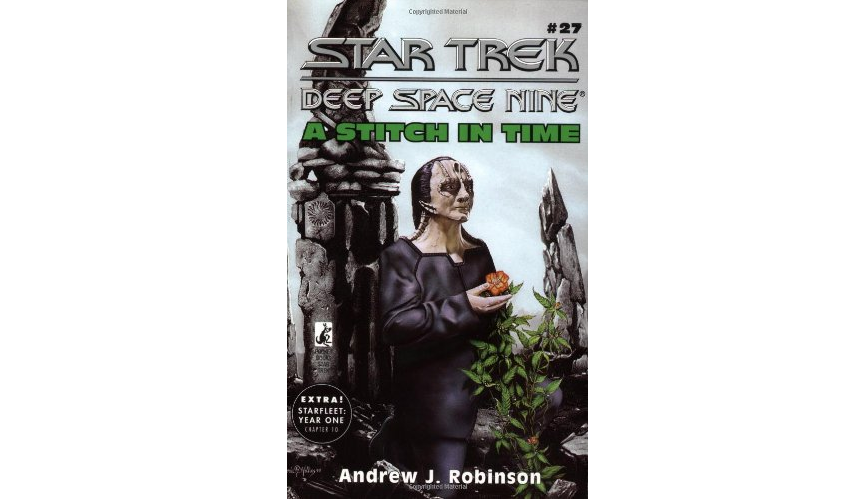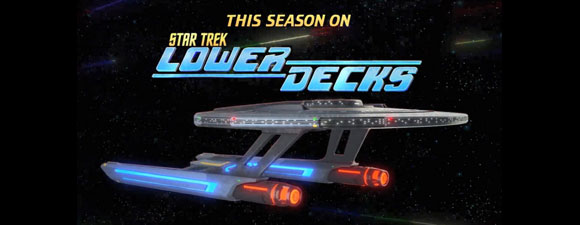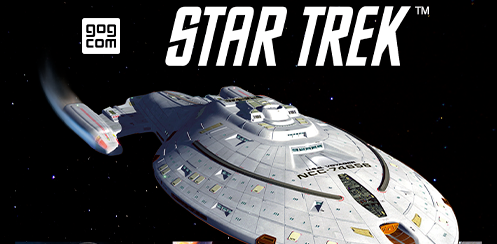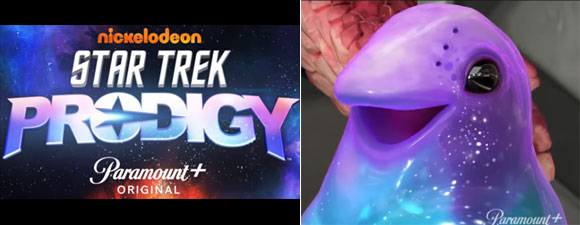Kenneth Hite Interview
By Christian Höhne SparborthPosted at November 1, 1999 - 6:00 AM GMT
We're speaking with Kenneth Hite, one of the designers working at Last Unicorn Games on their Star Trek role-playing games.
Trek Nation: You have worked as a designer on both the TNG and the TOS game. What precisely should we think of with this? Did you create the rules, the setting, some of the adventures, or all three these things? Could you perhaps shortly outline the design process for us?
Kenneth Hite: Essentially, way back in the early spring of 1998, Christian Moore of Last Unicorn Games asked me to come out to Los Angeles and help design the system and help write the STAR TREK: THE NEXT GENERATION ROLEPLAYING GAME. Working with him, with ST:TNG RPG Line Developer Ross Isaacs, and with legendary RPG author Steve Long, I helped design the core rules for the game, the Icon System. Basically, Christian had a central mechanic and some design goals -- the system had to be simple, replicate Star Trek type action, and use six-sided dice. Using those metrics, Ross and I worked out character creation, skills, and some other things; Steve then sewed muscle onto our skeletal system, added ship combat and ship design rules. All four of us (and Bill Bridges and Andrew Greenberg) interspersed our own ideas and concepts; the Icon System design was truly collaborative. Then Steve and I (mostly Steve) wrote the actual rules text.
Once we had that, we sent the rules out to be playtested while we wrote or edited the rest of the rule book text. I wound up writing both of the chapters on Narrating (which is what we called gamemastering) and essentially all of the Galaxy chapter (since I'd spent a few months working as an editor at an astrophysical journal). I also added some elements here and there. By that time, the playtest comments were back in; we adjusted the system and rules (mostly presentation, but some design) based on those, and the game released to some acclaim at GenCon in August of 1998, eventually winning the Origins Award for Best Roleplaying Game of 1998.
In December of 1998, Last Unicorn brought me on board full time as Line Developer for the STAR TREK ROLEPLAYING GAME, based on the original series. For that, since the rules design was done, I commissioned and edited setting and source text from the writers. We altered some of the rules text from the ST:TNG RPG, and rewrote over two thirds of the book to create a more "original-series" feel. I wound up writing part of it (no whole chapters, though, thank the Great Bird) and helped with art selection, graphic design, and everything else. The game came out, on schedule, at GenCon in August of 1999.
Since the upcoming STAR TREK: DEEP SPACE NINE ROLEPLAYING GAME will use the Icon System, I'll wind up credited as a designer on it, too, but the vast majority of the heavy lifting will have been done by its Line Developer, Steve Long.
Trek Nation: You recently released the Core Game Book for the Original Series RPG. For the benefit of the readers who haven't yet heard about this, could you give a brief rundown of what they will be able to find in it? Kenneth Hite: The STAR TREK ROLEPLAYING GAME core rulebook is a complete roleplaying game in one full-color hardback volume. Character creation (including ready-to-play archetypes and sample characters), ship design and combat, weapons, planets, a map of the Federation and a plan of the Constitution-class starship -- it's all in there. Chapters cover the Federation (you can play Humans, Vulcans, Tellarites, Andorians, Tiburonians and three other member species), Starfleet, technology, space, creatures, aliens (11 races including the Klingons, Romulans, Gorn, Tholians, Horta, and Medusans), gamemastering advice, and a ready-to-play adventure. Plus a picture of Kirk with his shirt off, for the ladies.
Trek Nation: Is this product just focused at experienced RPG players, or do you think it would also be able for Trek fans who have never participated in a role-playing game to enjoy Last Unicorn's Trek products? Does the core book include special provisions for fans who have never played any role-playing games before?
Trek Nation: When creating the game, did you focus more on the Trek setting or on the actual game mechanics? Do you think your game has any aspects which would also make it stand out were it not a Trek product?
Trek Nation: I understand that the TOS game is completely separate from the previously released TNG game and the upcoming DS9 game. How precisely do those various games vary from each other? And wouldn't it have been better to release a single rule book and produce special background books for the various series? (Especially for TNG and DS9, considering they both take place in the same timeline). Kenneth Hite: These three games vary greatly in feel and almost not at all in core mechanics; Last Unicorn's Icon System game line is similar to the Storyteller games (such as VAMPIRE, WEREWOLF, MAGE, WRAITH, etc.) from White Wolf in that respect. Watching the shows, each Trek has its own sensibility -- the original series is larger-than-life heroic swashbuckling adventure; The Next Generation is concerned with idealism, civilization, and progress; Deep Space Nine looks at the frontier and the gritty underbelly of the Star Trek universe. The writing, background material, and so forth in each game capture those divergent sensibilities -- as a result, each game has many chapters worth of material specific to the feel and the setting of each series.
As far as releasing background books rather than separate games, we're in something of a Catch-22. There are plenty of folks who only like one series well enough to game in it; they'd resent having to buy, say, the ST:TNG RPG core book *and* a supplement just to play in the 23rd century of the original series. This way, we offer a complete-in-one-volume game for fans of any of the three, without watering down any of the series' feel (especially given the great efforts the writers went to to differentiate Next Generation and Deep Space Nine) to produce a "compromise" core book.
Trek Nation: To what extent was Paramount involved with the creation of the game? Where there any features which you were forced to drop from the games due to Paramount's influence?
Trek Nation: Related to this, do the games allow the player to play as one of the characters from the actual television series? I realise it would of course be possible to create such characters, but do the game books also create templates for the series' characters? Kenneth Hite: Neither core book contains character sheets for the series regulars, although the ST:TNG RPG sourcebook THE PRICE OF FREEDOM has Next Generation regular character sheets. We'll probably put the original series regulars somewhere down the road, too. That said, as you point out, the books will certainly let you create your own versions of the regulars, if you want to play them.
Trek Nation: Also, how true to the actual series are the adventures that are possible with the RPGs? Are there, for instance, penalties for breaking the Prime Directive or such things? Kenneth Hite: Characters who act against Starfleet norms earn negative Renown; this will make it hard, or even impossible, for them to earn promotions, and will make other Starfleet characters (especially Starfleet Command) react to them poorly. Of course, if you save the galaxy from a space amoeba, you'll get some pretty positive Renown, so "Kirk-style" gaming is more than possible. Actually, the game is even truer to the series, in my opinion, than the series itself is: roleplaying doesn't need to worry about the effects budget.
Trek Nation: What makes Star Trek different from other works of science fiction? How did this influence the design of the games? Kenneth Hite: STAR TREK is not so much different from other works of SF as it is sui generis; for things to feel like a STAR TREK story there have to be certain elements like human action and free will, high levels of individual competence, optimism, and broadly "cinematic" action unconstrained by the minutiae of physics or history. Christian and the rest of us explicitly designed the mechanics to make those kinds of stories possible, and common -- high "graininess" of task resolution, broad skills, dramatic success more common than dramatic failure, and so forth. I personally wrote two chapters in the core book (and an entire supplement, the ST:TNG RPG NARRATOR'S TOOLKIT) covering those themes and suggesting modes and methods of conveying them in the game.
Trek Nation: In general, the Trek RPG products do not seem to be as well-known as other Trek merchandise, such as novels, computer games, or even the customizable card game. What do you think is the reason for this? Kenneth Hite: Basically, roleplaying games are a more selective hobby than reading, playing computer games, or playing card games. Thus, our potential audience is smaller. Also, we've only had products out for a little over a year -- give the audience a chance, I'm sure they'll come around.
Trek Nation: Before Last Unicorn premiered its Trek line, there was already the FASA Trek RPG and Task Force Games' 'Prime Directive.' Have you ever played any of those games, and did they influence you in creating this new line? Kenneth Hite: I played the original FASA game (STAR TREK: THE RPG) long ago, and admired it. We tried to keep the "character focus" of the FASA RPG alive in our games, and I think that shows in the character creation rules, especially our Background History rules that offer specialized training packages or tours of duty. I have never played (or even read) PRIME DIRECTIVE, although I played STAR FLEET BATTLES before it became insanely complex.
Trek Nation: A role-playing game can go beyond the TV shows and detail aspects not seen on screen. What areas do you wish to see developed for the RPG?
Trek Nation: WildStorm (the publisher of the Star Trek comics line) and Pocket Books the publisher of the Star Trek novels) are currently working closely together on creating a storyline for Deep Space Nine set after the seventh season. Is Last Unicorn planning to join them in this?
Trek Nation: Related to this, a few years ago Pocket Books launched the very popular 'New Frontier' series of books, which might now also be coming to comics. Has Last Unicorn ever considered doing something with this? Kenneth Hite: The same answer applies here, of course. But, we have plenty of work cut out for ourselves expanding the STAR TREK universe into roleplaying; if we had to read all the hundreds of novels and comics and so forth, we'd never get anything published.
Trek Nation: Lastly, what are your plans for the future of your Trek RPG line? I assume there will also be a 'Voyager' game? How long does your license still last? Kenneth Hite: I can't really answer questions about the license, since I don't know anything about it except that Paramount seems to like us. On a more informative note, in my line, I've got the Time Travel sourcebook ALL OUR YESTERDAYS, the Andorian sourcebook AMONG THE CLANS, and the Mirror Universe sourcebook THROUGH A GLASS DARKLY in production, and I just finished outlining FINAL FRONTIERS: THE STAR TREK RPG MOVIE SOURCEBOOK. Further on down the road, I've got sourcebooks on the Gorn, planetary cultures, and archaeology, along with boxed sets on the Rigel Sector (and the Orion pirates) and the Tholians. The ST:TNG RPG and ST:DS9 RPG both have full slates of releases, as well. I'm not involved in planning the VOYAGER line, but I assume we'll do a core book for it as well, or at least a Delta Quadrant sourcebook.
Trek Nation: Thanks for taking part in this interview!
Christian Höhne Sparborth is webmaster of the Trek Nation.



